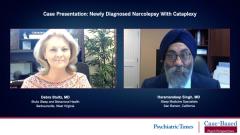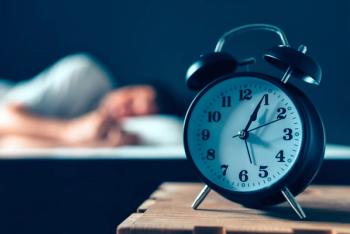
Approaching Treatment of Narcolepsy
In this custom video series, experts in sleep medicine discuss patient factors and symptoms they consider when selecting optimal treatment regimens for patients with narcolepsy.
Episodes in this series

Haramandeep Singh, MD: When you’re considering choosing a treatment regimen, what patient factors and symptoms come into play? How is the patient involved in that process in terms of choosing a treatment for them?
Debra Stultz, MD: That’s very important. The way I choose a lot of times is based on what the coexisting thing is. If they use alcohol, then I’m going to stay away from sodium oxybate, unless they’re drinking once or twice a month. Then you can hold your Xyrem that night and still be OK. But if they’re drinking pretty regularly, that’s not a medicine I’m going to use.
If they have a lot of anxiety, then I’m going to try to steer away from the stimulants that might cause more anxiety. If they have coexisting depression and cataplexy, I may go with more of the traditional antidepressants that might treat the symptoms. If they have trouble remembering to take medicines, then I’m going to use something that’s once a day in the morning. If they say, “I’m so rushed when I get out, I probably wouldn’t remember a morning medicine,” then I’m going to start looking to use 1 of the bedtime medicines that could treat the sleepiness and cataplexy. If they have cataplexy, as we talked about earlier, pitolisant or sodium oxybate would be a good choice because that would kill 2 birds with 1 stone. My decision is often based on what else is there.
Haramandeep Singh, MD: Absolutely. Having that conversation with a patient in terms of their other symptoms and their lifestyle is really important.
Debra Stultz, MD: Right.
Haramandeep Singh, MD: It’s exactly as we saw in that 20-year-old college-age student who is probably going out a few times a week, so it makes it clear for us that we want to try to use something that’s got less of a controlled substance. We want to avoid sodium oxybate. But then there’s the patient who has had a multitude of trials with modafinil, with stimulants. They tolerate them; they’re still sleepy. We know that with some of our narcoleptics, they need to be on 2 or 3 medications to get relief. Sometimes we’ll add pitolisant, or Wakix, on top of that, or add sodium oxybate, or taper them off 1 and get them on that. I appreciate that, in terms of the conversation you’re having with them.
Debra Stultz, MD: Yes. The majority of our patients with significant narcolepsy end up on a combination of medicines. When you think about it, we’re looking at different neurotransmitters and symptoms. We mentioned the birth control pill earlier. You can have trouble with the birth control pill with not only pitolisant but also modafinil and armodafinil. So maybe Sunosi is the choice there. If it’s a young woman of reproductive age, I’ll have the talk about that. They may be fine with taking that medicine while practicing safe sex, so we’re fine. But I have that discussion.
It depends on age, sex, who’s taking care of it, and who else lives in the family. I have patients who have narcolepsy, but also have a substance abusing child living at home. In those situations, I don’t want anything else. Even though they’re going to try to lock it up, I don’t want anything else there that can contribute. Even if my patient isn’t a substance abuser, I usually ask who’s at home. I want to make sure we’re not leaving medicines around. That could play into the decision as well.
Haramandeep Singh, MD: Absolutely. That conversation is so important in terms of delineating your therapy. Another area is Sunosi is cleared by the kidney, so if you’ve got a patient who’s on multiple other medications catalyzed by the liver, that’s another area where you could think about Sunosi. I’ve had young women with young children at home who may not want to take so much sodium oxybate at night, [to the point that] they feel as if they can’t wake up in the mornings. All these things, and having that conversation, are really important.
The good thing we find in today’s day and age, and what we’ve lacked in the past, is that we have options. This is an area in which we’ve finally gotten more standard of care. The AASM, the American Academy of Sleep Medicine, has made it clear that these are standards of care we should consider when we’re treating our patient.
Debra Stultz, MD: Yes. We’ve been so lucky in the field of narcolepsy. I’ve been doing sleep medicine for years, and narcolepsy has been my favorite disorder to treat. But for years, nobody was talking about it, and we didn’t have a lot of options. Then it just exploded with options. The wonderful thing about that is we’re getting the word out about narcolepsy to patients. Even if the providers are not as informed about narcolepsy, the patients are coming in saying, “I might have this,” or “Can we try this medicine?”
Haramandeep Singh, MD: Exactly.
Debra Stultz, MD: I love what it’s done to education of society.
Haramandeep Singh, MD: Absolutely. I totally agree with you.
Transcript edited for clarity.
Disclosures:
Dr Stultz has disclosed that she serves as a consultant on the advisory board for Harmony Biosciences and that she receives support in her role with the speaker’s bureau for Harmony Biosciences and Jazz Pharmaceuticals.
Dr Singh has disclosed that he serves as a consultant and receives support in his role with the speaker's bureau for Jazz Pharmaceuticals and Harmony Biosciences.
Newsletter
Receive trusted psychiatric news, expert analysis, and clinical insights — subscribe today to support your practice and your patients.





